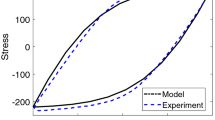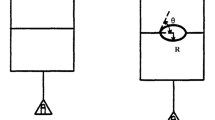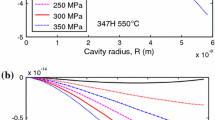Abstract
The transient cavity growth behaviour of liquid phase-sintered ceramics subject to compressive loads is examined. Three possible sources of transient behaviour are suggested, and their ranges of applicability evaluated. By considering the values of the characteristic time for individual transient modes, it has been determined that transient cavity growth in ceramics probably originates from transient grain-boundary sliding. Assuming that the creep-induced cavities nucleate and grow on grain boundaries that are parallel to the loading axis, a transient cavity growth model is developed on the basis that the local stress which drives cavity growth is induced by transient sliding of adjacent grain boundaries. Results of the proposed model are compared with small-angle neutron scattering measurements of a hot-pressed silicon carbide and a liquid phase-sintered alumina, both of which contain a continuous, amorphous grain-boundary phase. The different cavity growth behaviours observed in these ceramics are discussed in conjunction with transient grain-boundary sliding.
Similar content being viewed by others
References
R. A. Page and J. Lankford, J. Amer. Ceram. Soc.66 (1983) C-146.
R. A. Page, J. Lankford and S. Spooner, J. Mater. Sci.19 (1984) 3360.
Idem, Acta Metall.32 (1984) 1275.
J. Lankford, K. S. Chan and R. A. Page, in “Fracture Mechanics of Ceramics,” edited by R. C. Bradt, A. G. Evans, D. P. H. Hasselman and F. F. Lange (Plenum, New York, 1986) p. 327.
R. A. Page, J. Lankford, K. S. Chan, K. Hard-Man-Rhyne and S. Spooner, J. Amer. Ceram. Soc.70 (1987) 137.
K. S. Chan and R. A. Page, Metall. Trans. A18A (1987) 1843.
K. S. Chan, J. Lankford and R. A. Page, Acta Metall.32 (1984) 1908.
R. Raj, Metall. Trans. A6A (1975) 1499.
K. S. Chan and R. A. Page, J. Mater. Sci.25 (1990) 4622.
B. L. Vaandrager and G. M. Pharr, Acta Metall.37 (1989) 1057.
J. R. Dryden, D. Kucerovsky, D. S. Wilkinson and D. F. Watt, Acta Metall.37 (1989) 2007.
R. Raj and M. F. Ashby, Metall. Trans. A2 (1971) 1113.
R. Raj and C. K. Chyung, Acta Metall.29 (1981) 159.
S. M. Wiederhorn, B. J. Hockey, R. F. Krause, Jr. and K. Jakus, J. Mater. Sci.21 (1986) 810.
E. H. Rutter, Trans. Roy. Soc. A283 (1976) 203.
K. S. Chan, R. A. Page and J. Lankford, Acta Metall.34 (1986) 2361.
H. J. Frost and M. F. Ashby, “Deformation-Mechanism Maps” (Pergamon, New York, 1982) p. 98.
Author information
Authors and Affiliations
Rights and permissions
About this article
Cite this article
Chan, K.S., Page, R.A. Transient cavity growth in ceramics under compression. J Mater Sci 27, 1651–1658 (1992). https://doi.org/10.1007/BF00542929
Received:
Accepted:
Published:
Issue Date:
DOI: https://doi.org/10.1007/BF00542929




